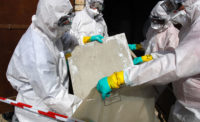A new set of laws set to go into effect April 1 aims to curb one of New York City’s most notorious problems: rats.
The New York City Council last year passed the Rat Action Plan, a package of four bills that set new pest management standards for city residents and at construction sites.
New York City has an estimated 2 million rats and in 2022, pest control company Orkin ranked New York second behind Chicago for rat infestation.
Mayor Eric Adams announced earlier this month that the city hired a Rat Czar and introduced a Rat Academy to help teach residents safe and effective ways to get rid of pests.
The Rat Action Plan will require applicants for certain construction work permits in New York City to certify that a licensed exterminator was retained to effectively treat the premises for rodent extermination.
Starting April 1, contractors will be required to pay for the cost of the extermination service for the following work, according to the New York City Council.
The rules apply to projects involving 50% or more of the floor area of a building; projects where the proposed vertical or horizontal enlargement increases the amount of a building’s floor area by more than 25%; and partial demolition projects involving more than 50% of the floor area of a building.

Big dumpsters sitting near construction sites for years at a time, often filled with lunch scraps, tend to attract rats to job sites.
Photo by Tom Sawyer
Rat sightings are up so far this year with nearly 7,900 complaints across the five boroughs, the city reported.
The regulations will have a direct impact on contractors in the city and the construction industry.
“Construction activity is essential to grow and properly maintain the buildings in our city,” said Kazimir Vilenchik, acting New York City Dept. of Buildings commissioner. “But construction work is also responsible for driving rodents from their hiding holes out onto our city street and sidewalks. By building upon existing regulations to mitigate rodent populations in and around construction sites, this new legislation is a decisive step towards turning the tide in our fight with the four-legged menace.”
In November, Adams signed into law Intro 0442-2022, a local law to amend the administrative code of the City of New York and the New York city building code, in relation to abating rodents as a requirement for the issuance of certain construction permits.
The new law extends the existing rodent extermination requirement for full demolition projects and also extends it to more types of construction projects.
“For years, the Dept. of Buildings has required property owners to hire exterminators to perform rodent abatement operations at work sites prior to the start of full demolition projects in New York City,” said Andrew Rudansky, a spokesman for the NYC Dept. of Buildings.
The law requires that before a permit authorizing certain construction work that is subject to rodent extermination is issued, the applicant certifies that a licensed exterminator was retained to effectively treat the premises for rodent extermination.
“During the application process for a full demolition project, the applicant is required to produce a “Pre-Demolition Rodent Extermination Certificate” indicating that a licensed exterminator has properly inspected and baited the property to mitigate rodent issues,” Rudansky said.
During the application process, the DOB will check to confirm that this certificate has been submitted prior to approving a proposed full building demolition project in New York City.
While Gilbane Building Co. says it already practices rat mitigation, it "intends" to follow the new guidelines, said Wes Cotter, the firm's director of corporate communications.
“On all our project sites we have an active housekeeping policy that includes continual cleaning throughout the project area and removal of refuse,” Gilbane said in a statement provided by Cotter. “We also hire professional services to prevent and mitigate the presence of rodents on our job sites.”
The hole created for the construction of a new subway access stairway for the 6th Avenue Line and the PATH trains at 14th St. and 6th Ave. sits in front of a building under construction, making it hard for the building's contractors to control rats on job sites.
Photo by Tom Sawyer
The New York Building Congress also supports the legislation.
“Our members will continue to provide cleaner, safer and eventually rat-free job sites,” said Carlo Scissura, NYBC president and CEO said in a press release. “Assuring that is not only good for our undaunted workers but New Yorkers in general.”
The new laws will affect both residential and commercial construction projects.
In a statement, Metropolitan Transportation Authority Spokesperson Sean Butler said, “The MTA has its own rat reduction program and appreciates the added focus on construction sites, which often are an undesired source of rodents moving into the subway system.”
To control the rat population, the MTA has a team that uses bait and rodenticide along the trackway to control the rat population in the tunnels. They focus on tracks in station areas to prevent tunnel rats from moving to the customer areas of the stations. The locations change monthly as locations are addressed and new areas are identified for work.
The new plan also focuses on keeping existing properties rat free. The Rat Action Plan laws apply only to buildings that have been designated in rat mitigation zones for at least seven months. It also requires the Dept. of Health and Mental Hygiene to designate rat mitigation zones by no later than April 1 and to set times buildings must set out their garbage for collection.
City residents have filed nearly 36,000 rodent complaints in 2022, which was more than the number of complaints filed in 2019, according to city data.



Post a comment to this article
Report Abusive Comment